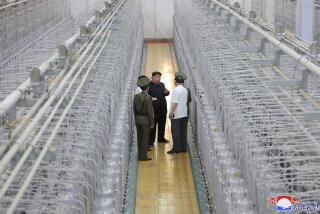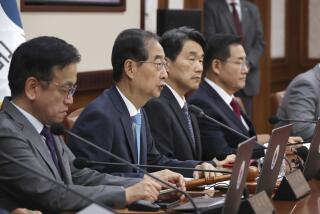South Korea wraps up military exercises, ponders possible nuclear test next year by the North
- Share via
Reporting from Seoul — South Korea’s military Friday wrapped up three days of intense land and sea exercises as officials tried to decipher what a third nuclear test by North Korea predicted for next year would mean to already brittle relations between the two nations.
Tension on the peninsula recently has been at one of their highest levels since a truce ended the direct combat of the Korean War in 1953.
Northern artillery shelled the South’s Yeonpyeong Island on Nov. 23, killing four people, and South Korea followed with two live-fire training exercises despite threats from Pyongyang that it could retaliate if it felt threatened.
One top North Korean official called the latest drills a “grave military provocation” and even threatened a “sacred” nuclear war if the South attacked.
A report released Friday predicting that the North could carry out a third nuclear test as early as next year also did nothing to erase the growing unease. Pyongyang carried out tests in 2006 and 2009.
“There is a possibility of North Korea carrying out its third nuclear test to seek improvement in its nuclear weapons production capability, keep the military tension high and promote Kim Jong Eun’s status as the next leader,” said the report by a South Korean Foreign Ministry institute, referring to Northern leader Kim Jong Il’s youngest son and presumed successor.
Another report released Thursday says that the rising tension between Pyongyang and Seoul has “created a serious risk that any further provocation might turn into a wider conflict.”
That study, by the Brussels-based International Crisis Group think tank, says that though the North would lose a war against its southern neighbor, “Seoul is constrained in retaliating forcefully because it has so much to lose” both economically and politically.
“Pyongyang, isolated from global markets and domestic political forces, does not face such constraints,” the report says. “Rather, the disparity permits it to provoke the South at very little cost, even while falling behind in the overall balance of conventional forces.”
Dressed in green military fatigues, South Korean President Lee Myung-bak on Thursday visited a base near the heavily guarded demilitarized zone that separates the two nations, watching a massive display of force by his tanks and fighter jets.
On Friday, the South Korean navy ended the military drills with exercises off the nation’s less-tense eastern border.
Lee has been under pressure to get tough on Pyongyang since a South Korean warship sank in March, allegedly after being hit by a torpedo. The North was widely blamed for the sinking, which killed 46 crew members. After the North’s artillery bombardment last month of Yeonpyeong Island, Seoul replaced its defense minister and has assumed a more aggressive defense posture.
“I had thought that we could safeguard peace if we had patience, but that wasn’t the case,” Lee told the troops during his visit, his office reported. Any surprise attack would be met with a “merciless” response, he said.
More to Read
Sign up for Essential California
The most important California stories and recommendations in your inbox every morning.
You may occasionally receive promotional content from the Los Angeles Times.














